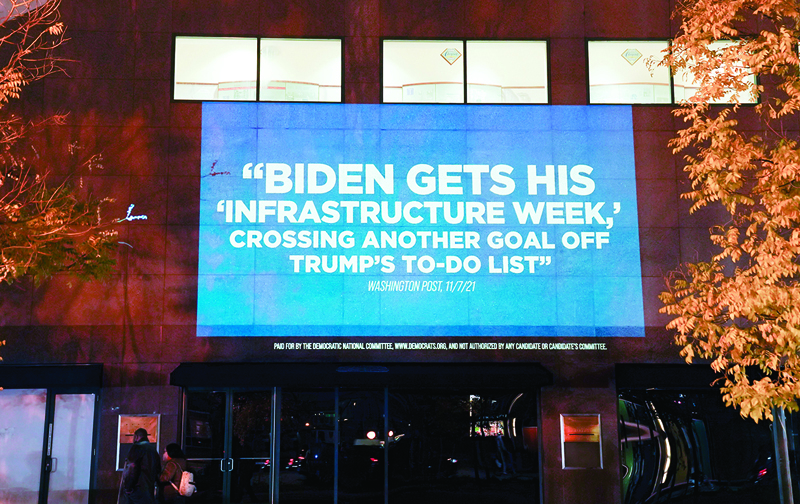 BALTIMORE, Maryland: DNC celebrates President Biden and Democrats delivering on the Bipartisan Infrastructure Deal by projecting video on a wall in the Inner Harbor of Baltimore on November 9 in Baltimore, Maryland. - AFP
BALTIMORE, Maryland: DNC celebrates President Biden and Democrats delivering on the Bipartisan Infrastructure Deal by projecting video on a wall in the Inner Harbor of Baltimore on November 9 in Baltimore, Maryland. - AFP
WASHINGTON: US President Joe Biden hits the road yesterday to show off the huge new infrastructure bill passed last week, hoping to reap its benefits politically even as he watches his approval ratings slump. The Democratic president chose Baltimore, a port city less than an hour's drive from Washington, to explain to the nation why and how the country will spend $1.2 trillion on its sagging infrastructure.
On Monday evening, in an interview on local television in Cincinnati, Ohio, the Democratic leader insisted it would only be a "matter of weeks" before the effects of the massive investment plan would start to be seen. Days earlier he had predicted it would be "two to three months" before the public starts to see the real effects of the bill on expanding internet networks, roads, bridges, drinking water pipes, electric car charging stations and a slew of other projects.
The president is counting on the program producing an impact-at least politically-before Americans vote in midterm elections in a year's time. That election, traditionally a challenge for the party in power, could well cost the Democrats their slim majority in Congress. In the meantime, Biden's cabinet has been rallying to play up the legislative win, while the president is trying to mobilize local party officials to provide after-sales service for the gigantic spending bill.
It is popular in principle, but its precise details remain unclear to the wider public, especially after weeks of complicated negotiations in Congress. And another battle is already underway in Congress over the other part of Biden's ambitious economic and social reform agenda: an up to $1.85 trillion plan that includes major investments in health, education, tackling climate change and expanding social welfare programs.
'Tell a story'
After Baltimore, the president will continue to plug his message on the ground, deputy White House spokeswoman Karine Jean-Pierre said Tuesday. Biden likely has the experience of Barack Obama-under whom he served as vice president-in mind. Obama steered through a huge stimulus package totaling almost $800 billion in 2009, with vastly differing economic and political results. While the measure rebooted the recession-hit economy, Republicans racked up a strong surge in the following midterm elections.
Obama later surmised that his mistake had been to forget that, beyond the process of making decisions, the president must also "tell a story to the American people that gives them a sense of unity and purpose and optimism, especially during tough times." That is what Biden, whose White House is full of former senior officials from the Obama administration, appears to be trying to do now. The president said on Saturday he was convinced that "50 years from now, folks are going to look back and say, 'This was the moment, this was the period, this year and the next couple years, when America decided to win the competition of the 21st century'" in the face of rivalry with China and the threat of climate change.
Right now, however, Americans are more concerned about skyrocketing gasoline prices, supply chain problems and a pandemic that has yet to be fully reined in. On Tuesday, Biden's approval rating stood at 42.8 percent, according to political analysis website FiveThirtyEight, which amalgamates various polls. At the same point in their terms, only two presidents in recent US history have polled worse, according to FiveThirtyEight: Gerald Ford, with 38.4 percent in November 1974, and Donald Trump, with just 37.9 percent in November 2017. -AFP
.jpg)



